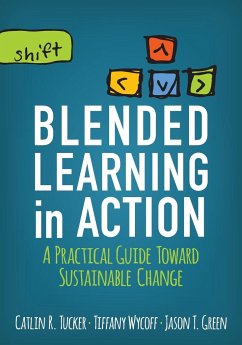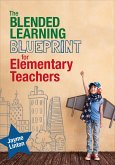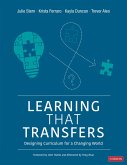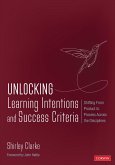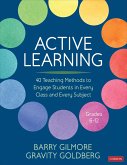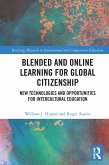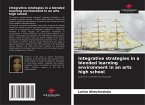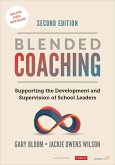Catlin R. Tucker, Tiffany Wycoff, Jason T. Green
Blended Learning in Action
A Practical Guide Toward Sustainable Change
27,99 €
inkl. MwSt.
Versandfertig in 6-10 Tagen

14 °P sammeln
Catlin R. Tucker, Tiffany Wycoff, Jason T. Green
Blended Learning in Action
A Practical Guide Toward Sustainable Change
- Broschiertes Buch
- Merkliste
- Auf die Merkliste
- Bewerten Bewerten
- Teilen
- Produkt teilen
- Produkterinnerung
- Produkterinnerung
Shift to blended learning to transform education
Blended learning has the power to reinvent education, but transitioning to a blended model is challenging. Blended learning requires a fundamentally new approach to learning as well as a new skillset for both teachers and school leaders. Loaded with research, examples, and resources, Blended Learning in Action demonstrates the advantages a blended model has over traditional instruction when technology is used to engage students both inside the classroom and online. Readers will find: Breakdowns of the most effective classroom setups for…mehr
Andere Kunden interessierten sich auch für
![The Blended Learning Blueprint for Elementary Teachers The Blended Learning Blueprint for Elementary Teachers]() Jayme LintonThe Blended Learning Blueprint for Elementary Teachers29,99 €
Jayme LintonThe Blended Learning Blueprint for Elementary Teachers29,99 €![Learning That Transfers Learning That Transfers]() Julie SternLearning That Transfers44,99 €
Julie SternLearning That Transfers44,99 €![Unlocking: Learning Intentions Unlocking: Learning Intentions]() Shirley ClarkeUnlocking: Learning Intentions27,99 €
Shirley ClarkeUnlocking: Learning Intentions27,99 €![Active Learning Active Learning]() Barry GilmoreActive Learning42,99 €
Barry GilmoreActive Learning42,99 €![Blended and Online Learning for Global Citizenship Blended and Online Learning for Global Citizenship]() William HunterBlended and Online Learning for Global Citizenship37,99 €
William HunterBlended and Online Learning for Global Citizenship37,99 €![Integrative strategies in a blended learning environment in an arts high school Integrative strategies in a blended learning environment in an arts high school]() Larisa AhmylovskajaIntegrative strategies in a blended learning environment in an arts high school42,99 €
Larisa AhmylovskajaIntegrative strategies in a blended learning environment in an arts high school42,99 €![Blended Coaching Blended Coaching]() Gary S. BloomBlended Coaching28,99 €
Gary S. BloomBlended Coaching28,99 €-
-
-
Shift to blended learning to transform education
Blended learning has the power to reinvent education, but transitioning to a blended model is challenging. Blended learning requires a fundamentally new approach to learning as well as a new skillset for both teachers and school leaders. Loaded with research, examples, and resources, Blended Learning in Action demonstrates the advantages a blended model has over traditional instruction when technology is used to engage students both inside the classroom and online. Readers will find:
Breakdowns of the most effective classroom setups for blended learning Guidelines to build a blended learning toolbox of tech and resources Tips for leaders Ideas for personalizing and differentiating instruction using technology Strategies for managing devices in classrooms and schools Study questions to facilitate professional development and deeper learning
Written with system-wide transformation in mind, this is the resource teachers and leaders need to help them shift to a blended learning model and transform education for today's learning environment.
"The time for blended learning is now and the place is ALL classrooms throughout the country. This book provides educators with essential information and practices that will prepare students for the 21st Century."
Kim Weber, 4th Grade Teacher
Mandell School, New York, NY
"This book is different. It is deeper and more serious about creating the change students deserve than most others. The fact that each and every chapter starts out with a student's perspective confirms that it is built on a vital pedagogical foundation."
Brad Gustafson, Principal and Author of Renegade Leadership
Greenwood Elementary, Wayzata, MN
Blended learning has the power to reinvent education, but transitioning to a blended model is challenging. Blended learning requires a fundamentally new approach to learning as well as a new skillset for both teachers and school leaders. Loaded with research, examples, and resources, Blended Learning in Action demonstrates the advantages a blended model has over traditional instruction when technology is used to engage students both inside the classroom and online. Readers will find:
Breakdowns of the most effective classroom setups for blended learning Guidelines to build a blended learning toolbox of tech and resources Tips for leaders Ideas for personalizing and differentiating instruction using technology Strategies for managing devices in classrooms and schools Study questions to facilitate professional development and deeper learning
Written with system-wide transformation in mind, this is the resource teachers and leaders need to help them shift to a blended learning model and transform education for today's learning environment.
"The time for blended learning is now and the place is ALL classrooms throughout the country. This book provides educators with essential information and practices that will prepare students for the 21st Century."
Kim Weber, 4th Grade Teacher
Mandell School, New York, NY
"This book is different. It is deeper and more serious about creating the change students deserve than most others. The fact that each and every chapter starts out with a student's perspective confirms that it is built on a vital pedagogical foundation."
Brad Gustafson, Principal and Author of Renegade Leadership
Greenwood Elementary, Wayzata, MN
Produktdetails
- Produktdetails
- Corwin Teaching Essentials
- Verlag: Corwin / Sage Publications
- Seitenzahl: 226
- Erscheinungstermin: 29. September 2016
- Englisch
- Abmessung: 254mm x 178mm x 13mm
- Gewicht: 611g
- ISBN-13: 9781506341163
- ISBN-10: 1506341160
- Artikelnr.: 45060105
- Herstellerkennzeichnung
- Libri GmbH
- Europaallee 1
- 36244 Bad Hersfeld
- gpsr@libri.de
- Corwin Teaching Essentials
- Verlag: Corwin / Sage Publications
- Seitenzahl: 226
- Erscheinungstermin: 29. September 2016
- Englisch
- Abmessung: 254mm x 178mm x 13mm
- Gewicht: 611g
- ISBN-13: 9781506341163
- ISBN-10: 1506341160
- Artikelnr.: 45060105
- Herstellerkennzeichnung
- Libri GmbH
- Europaallee 1
- 36244 Bad Hersfeld
- gpsr@libri.de
Catlin Tucker is a Google Certified Innovator, bestselling author, international trainer, and frequent Edtech speaker, who teaches in Sonoma County where she was named Teacher of the Year in 2010. Catlin's books Blended Learning in Grades 4-12 and Blended Learning in Action are both bestsellers. She has also written a book titled Creatively Teach the Common Core Literacy Standards with Technology to support teachers in thinking outside of the box as they shift to the Common Core. Catlin is working on her doctorate at Pepperdine University. She writes the "Techy Teacher" column for ASCD's Educational Leadership. She is active on Twitter @Catlin_Tucker and writes an internationally ranked education blog at CatlinTucker.com.
Preface
Acknowledgments
About the Authors
Introduction
PART 1. SHIFTING TO A BLENDED CULTURE
Chapter 1. Going Blended to Meet the World
Scaling Blended Learning Transformation
Clearing Up Blended Learning Confusion
It Starts With Culture
A Blended Learning Culture
Where the World Is Going: Our Students Are Already There
Wrapping It Up
Book Study Questions
Chapter 2. Getting Started
Phase 1: Building the Foundation
Stage 1: Engagement and Vision-Cohesion of Vision and Pedagogy
Stage 2: Assess-What Is Our Starting Point?
Links to the Classroom: Participating in Discussions About Mindset
Stage 3: Planning and Design
Stage 4: Pre-Pilot
Identifying and Enlisting Pre-Pilot Teachers
Links to the Classroom: Engaging Student Voice in Pre-Pilots
Wrapping It Up
Book Study Questions
Chapter 3. The Blended Learning Elements of Effectiveness
The Elements Described
Cohesion of Vision and Pedagogy
Capacity Building
Links to the Classroom: Building Student Capacity
Technology Utilization
Links to the Classroom: Getting Creative With Limited Resources
Data Management and Usage
Student Ownership
Wrapping It Up
Book Study Questions
Chapter 4. Preparing Teachers for Blended Instruction
What Works in Professional Development
Guiding Principle of Blended Learning Professional Development #1: As the Student, So the Teacher (CHOMP)
Links to the Classroom: Help Students Connect
Hands-On Learning
Ongoing Learning
Mindset Shifts: Start With the Why Not the What
Personalize Choice, Differentiation, Pace, and Skills
Links to the Classroom: What Are Your Strengths Now?
Guiding Principle of Blended Learning Professional Development #2: Differentiate to Cross the Chasm
Wrapping It Up
Book Study Questions
PART 2. BLENDED LEARNING TOOLBOX
Chapter 5. Devices and Digital Tools
Different Tools for a Different Generation
Building Blocks of a Digital Classroom
Links to Leadership: Supporting an Iterative Practice
Productivity and Collaboration Environments
Learning Management Systems
Links to Leadership: Access to Technology
Links to Leadership: Professional Development
Building Technology Toolboxes to Promote Technology Fluency
Deciding on the Right Device
Which Funding Model Is the Best Fit?
Links to Leadership: Engage Stakeholder Voices
Mobile Devices
Tablets
Chromebooks
Laptops
Finding the Right Tool
Stay Connected and Keep Learning
Wrapping It Up
Book Study Questions
Chapter 6. Digital Curriculum
What Is Digital Curriculum?
Types of Digital Curriculum
What Are the Benefits of Digital Curriculum?
How Can Digital Curriculum Foster Student Ownership?
What Are the Challenges of Using Digital Curriculum?
How Do I Select the Right Digital Curriculum?
Links to Leadership: Helping Teachers Select the Best-Fit Digital Curriculum
Build Capacity Through Committees
Engage Students as Owners via Student Input
Build Capacity Through Professional Development
Digital Curriculum and the Planning Process
Organizing and Sharing Digital Curriculum
Links to Leadership: Helping Teams Plan Together
Digital Curriculum in Blended Learning Models
Whole-Group Rotation Digital Curriculum Integration
Station Rotation Digital Curriculum Integration
Flipped Class Digital Curriculum Integration
Wrapping It Up
Book Study Questions
Chapter 7. Assessment in a Blended Environment
What Do We Really Mean by Assessment?
What Drives Student Learning?
Reading and Responding to the Data Narrative
Links to Leadership: Tools and Time for Managing Data
Maximizing the LMS
Beyond Grades and Data
Making It Personal
Leading and Learning With Formative Assessment
How Can Formative Assessment Foster Student Ownership?
What Are the Challenges of Assessment in the Blended Environment?
Wrapping It Up
Book Study Questions
Chapter 8. Onboarding and Supporting Students
Why Do We Need to Onboard "Digital Natives"?
What Do We Mean by Onboarding?
Onboarding Through Effective Backward Design
Links to Leadership: Establishing a Schoolwide Onboarding Practice
Build Capacity Through Student Trailblazers and Buddy Programs
Engage Students in Peer Support Systems
Embracing Teachable Moments
Wrapping It Up
Book Study Questions
PART 3. BLENDED LEARNING: EXPLORING CLASSROOM MODELS
Chapter 9. Station Rotation Model
What Is the Station Rotation Model?
What Are the Benefits of the Station Rotation Model?
Station Rotation Model Can Take Many Forms
Links to Leadership: Access to Technology
Planning a Station Rotation Lesson
Station Rotation Lesson Template
Links to Leadership: Helping Teachers to Meet and Overcome Challenges
Building Capacity
Additional Staffing or Parent Volunteers
Tip for Designing a Station Rotation: Go Horizontal With Your Traditional Agenda
Design a Station Rotation to Target a Specific Skill
What Are Some of the Challenges Associated With the Station Rotation Model?
Logistical Concerns
Grouping Strategies
What Is the Teacher's Role During a Station Rotation Lesson?
Wrapping It Up
Book Study Questions
Chapter 10. Whole Group Rotation: A Modern Spin on the Lab Rotation
What Is the Whole Group Rotation?
What Are the Benefits of the Whole Group Rotation?
Designing a Whole Group Rotation Lesson
Whole Group Rotation: Sample Lessons
Whole Group Rotation: Drag-and-Drop Lesson Template
What Are Some of the Challenges Associated With the Whole Group Rotation?
Links to Leadership: Access to Technology
Logistical Concerns
How can I make sure students are on task during online work?
How can I make time to work one-on-one with students?
Wrapping It Up
Book Study Questions
Chapter 11. The Flipped Classroom
What Is the Flipped Classroom?
What Are the Benefits of the Flipped Classroom?
Designing a Flipped Classroom Lesson
Step 1: Pique Interest, Drive Inquiry, or Assess Previous Knowledge
Step 2: Flip and Engage Online
Step 3: Design Student-Centered Application Activities
Example of a Flipped Vocabulary Lesson
Flipping With Different Types of Media
Flipping With Text
Flipping With Images
Flipping With Video
Flip AND Engage
Links to Leadership: Access to Technology
Producing and Publishing Your own Flipped Videos
Step 1: Creating Content
Step 2: Recording Videos or Screencasts
Step 3: Exporting to YouTube or a Video Hosting Site
Links to Leadership: Building Capacity
What Are Some of the Challenges Associated With the Flipped Classroom?
In-Class Flip
Wrapping It Up
Book Study Questions
Chapter 12. Other Models and Possibilities
Individualized Models and Possibilities
Individual Rotations and Playlists Defined
Links to Leadership: Managing Technology Platforms
What Are the Benefits of the Individual Playlist Model?
Designing and Supporting Individual Playlists
Building Community
What Is the Teacher's Role During an Individual Playlist Experience?
Links to Leadership: Helping Teachers to Facilitate Learning
A La Carte Model Defined
How Do Schools Select Course Providers for A La Carte Integration?
Links to Leadership: Logistics of A La Carte Learning
What Are the Benefits of the A La Carte Model?
Designing and Supporting A La Carte
Links to Leadership: Role Definition and Policy
Building Capacity Through Onsite Facilitator Training and Networking
Beyond the Models
Wrapping It Up
Book Study Questions
PART 4. BLENDED LEARNING: THE ROADMAP TO PERSONALIZATION
Chapter 13. The Roadmap to Personalization
The Path Forward to Personalization
Phase 2: Transitions
Phase 3: Expansion
Achieving Sustainability
The Responsibility of Teaching "They"
Wrapping It Up
Book Study Questions
References
Index
Acknowledgments
About the Authors
Introduction
PART 1. SHIFTING TO A BLENDED CULTURE
Chapter 1. Going Blended to Meet the World
Scaling Blended Learning Transformation
Clearing Up Blended Learning Confusion
It Starts With Culture
A Blended Learning Culture
Where the World Is Going: Our Students Are Already There
Wrapping It Up
Book Study Questions
Chapter 2. Getting Started
Phase 1: Building the Foundation
Stage 1: Engagement and Vision-Cohesion of Vision and Pedagogy
Stage 2: Assess-What Is Our Starting Point?
Links to the Classroom: Participating in Discussions About Mindset
Stage 3: Planning and Design
Stage 4: Pre-Pilot
Identifying and Enlisting Pre-Pilot Teachers
Links to the Classroom: Engaging Student Voice in Pre-Pilots
Wrapping It Up
Book Study Questions
Chapter 3. The Blended Learning Elements of Effectiveness
The Elements Described
Cohesion of Vision and Pedagogy
Capacity Building
Links to the Classroom: Building Student Capacity
Technology Utilization
Links to the Classroom: Getting Creative With Limited Resources
Data Management and Usage
Student Ownership
Wrapping It Up
Book Study Questions
Chapter 4. Preparing Teachers for Blended Instruction
What Works in Professional Development
Guiding Principle of Blended Learning Professional Development #1: As the Student, So the Teacher (CHOMP)
Links to the Classroom: Help Students Connect
Hands-On Learning
Ongoing Learning
Mindset Shifts: Start With the Why Not the What
Personalize Choice, Differentiation, Pace, and Skills
Links to the Classroom: What Are Your Strengths Now?
Guiding Principle of Blended Learning Professional Development #2: Differentiate to Cross the Chasm
Wrapping It Up
Book Study Questions
PART 2. BLENDED LEARNING TOOLBOX
Chapter 5. Devices and Digital Tools
Different Tools for a Different Generation
Building Blocks of a Digital Classroom
Links to Leadership: Supporting an Iterative Practice
Productivity and Collaboration Environments
Learning Management Systems
Links to Leadership: Access to Technology
Links to Leadership: Professional Development
Building Technology Toolboxes to Promote Technology Fluency
Deciding on the Right Device
Which Funding Model Is the Best Fit?
Links to Leadership: Engage Stakeholder Voices
Mobile Devices
Tablets
Chromebooks
Laptops
Finding the Right Tool
Stay Connected and Keep Learning
Wrapping It Up
Book Study Questions
Chapter 6. Digital Curriculum
What Is Digital Curriculum?
Types of Digital Curriculum
What Are the Benefits of Digital Curriculum?
How Can Digital Curriculum Foster Student Ownership?
What Are the Challenges of Using Digital Curriculum?
How Do I Select the Right Digital Curriculum?
Links to Leadership: Helping Teachers Select the Best-Fit Digital Curriculum
Build Capacity Through Committees
Engage Students as Owners via Student Input
Build Capacity Through Professional Development
Digital Curriculum and the Planning Process
Organizing and Sharing Digital Curriculum
Links to Leadership: Helping Teams Plan Together
Digital Curriculum in Blended Learning Models
Whole-Group Rotation Digital Curriculum Integration
Station Rotation Digital Curriculum Integration
Flipped Class Digital Curriculum Integration
Wrapping It Up
Book Study Questions
Chapter 7. Assessment in a Blended Environment
What Do We Really Mean by Assessment?
What Drives Student Learning?
Reading and Responding to the Data Narrative
Links to Leadership: Tools and Time for Managing Data
Maximizing the LMS
Beyond Grades and Data
Making It Personal
Leading and Learning With Formative Assessment
How Can Formative Assessment Foster Student Ownership?
What Are the Challenges of Assessment in the Blended Environment?
Wrapping It Up
Book Study Questions
Chapter 8. Onboarding and Supporting Students
Why Do We Need to Onboard "Digital Natives"?
What Do We Mean by Onboarding?
Onboarding Through Effective Backward Design
Links to Leadership: Establishing a Schoolwide Onboarding Practice
Build Capacity Through Student Trailblazers and Buddy Programs
Engage Students in Peer Support Systems
Embracing Teachable Moments
Wrapping It Up
Book Study Questions
PART 3. BLENDED LEARNING: EXPLORING CLASSROOM MODELS
Chapter 9. Station Rotation Model
What Is the Station Rotation Model?
What Are the Benefits of the Station Rotation Model?
Station Rotation Model Can Take Many Forms
Links to Leadership: Access to Technology
Planning a Station Rotation Lesson
Station Rotation Lesson Template
Links to Leadership: Helping Teachers to Meet and Overcome Challenges
Building Capacity
Additional Staffing or Parent Volunteers
Tip for Designing a Station Rotation: Go Horizontal With Your Traditional Agenda
Design a Station Rotation to Target a Specific Skill
What Are Some of the Challenges Associated With the Station Rotation Model?
Logistical Concerns
Grouping Strategies
What Is the Teacher's Role During a Station Rotation Lesson?
Wrapping It Up
Book Study Questions
Chapter 10. Whole Group Rotation: A Modern Spin on the Lab Rotation
What Is the Whole Group Rotation?
What Are the Benefits of the Whole Group Rotation?
Designing a Whole Group Rotation Lesson
Whole Group Rotation: Sample Lessons
Whole Group Rotation: Drag-and-Drop Lesson Template
What Are Some of the Challenges Associated With the Whole Group Rotation?
Links to Leadership: Access to Technology
Logistical Concerns
How can I make sure students are on task during online work?
How can I make time to work one-on-one with students?
Wrapping It Up
Book Study Questions
Chapter 11. The Flipped Classroom
What Is the Flipped Classroom?
What Are the Benefits of the Flipped Classroom?
Designing a Flipped Classroom Lesson
Step 1: Pique Interest, Drive Inquiry, or Assess Previous Knowledge
Step 2: Flip and Engage Online
Step 3: Design Student-Centered Application Activities
Example of a Flipped Vocabulary Lesson
Flipping With Different Types of Media
Flipping With Text
Flipping With Images
Flipping With Video
Flip AND Engage
Links to Leadership: Access to Technology
Producing and Publishing Your own Flipped Videos
Step 1: Creating Content
Step 2: Recording Videos or Screencasts
Step 3: Exporting to YouTube or a Video Hosting Site
Links to Leadership: Building Capacity
What Are Some of the Challenges Associated With the Flipped Classroom?
In-Class Flip
Wrapping It Up
Book Study Questions
Chapter 12. Other Models and Possibilities
Individualized Models and Possibilities
Individual Rotations and Playlists Defined
Links to Leadership: Managing Technology Platforms
What Are the Benefits of the Individual Playlist Model?
Designing and Supporting Individual Playlists
Building Community
What Is the Teacher's Role During an Individual Playlist Experience?
Links to Leadership: Helping Teachers to Facilitate Learning
A La Carte Model Defined
How Do Schools Select Course Providers for A La Carte Integration?
Links to Leadership: Logistics of A La Carte Learning
What Are the Benefits of the A La Carte Model?
Designing and Supporting A La Carte
Links to Leadership: Role Definition and Policy
Building Capacity Through Onsite Facilitator Training and Networking
Beyond the Models
Wrapping It Up
Book Study Questions
PART 4. BLENDED LEARNING: THE ROADMAP TO PERSONALIZATION
Chapter 13. The Roadmap to Personalization
The Path Forward to Personalization
Phase 2: Transitions
Phase 3: Expansion
Achieving Sustainability
The Responsibility of Teaching "They"
Wrapping It Up
Book Study Questions
References
Index
Preface
Acknowledgments
About the Authors
Introduction
PART 1. SHIFTING TO A BLENDED CULTURE
Chapter 1. Going Blended to Meet the World
Scaling Blended Learning Transformation
Clearing Up Blended Learning Confusion
It Starts With Culture
A Blended Learning Culture
Where the World Is Going: Our Students Are Already There
Wrapping It Up
Book Study Questions
Chapter 2. Getting Started
Phase 1: Building the Foundation
Stage 1: Engagement and Vision-Cohesion of Vision and Pedagogy
Stage 2: Assess-What Is Our Starting Point?
Links to the Classroom: Participating in Discussions About Mindset
Stage 3: Planning and Design
Stage 4: Pre-Pilot
Identifying and Enlisting Pre-Pilot Teachers
Links to the Classroom: Engaging Student Voice in Pre-Pilots
Wrapping It Up
Book Study Questions
Chapter 3. The Blended Learning Elements of Effectiveness
The Elements Described
Cohesion of Vision and Pedagogy
Capacity Building
Links to the Classroom: Building Student Capacity
Technology Utilization
Links to the Classroom: Getting Creative With Limited Resources
Data Management and Usage
Student Ownership
Wrapping It Up
Book Study Questions
Chapter 4. Preparing Teachers for Blended Instruction
What Works in Professional Development
Guiding Principle of Blended Learning Professional Development #1: As the Student, So the Teacher (CHOMP)
Links to the Classroom: Help Students Connect
Hands-On Learning
Ongoing Learning
Mindset Shifts: Start With the Why Not the What
Personalize Choice, Differentiation, Pace, and Skills
Links to the Classroom: What Are Your Strengths Now?
Guiding Principle of Blended Learning Professional Development #2: Differentiate to Cross the Chasm
Wrapping It Up
Book Study Questions
PART 2. BLENDED LEARNING TOOLBOX
Chapter 5. Devices and Digital Tools
Different Tools for a Different Generation
Building Blocks of a Digital Classroom
Links to Leadership: Supporting an Iterative Practice
Productivity and Collaboration Environments
Learning Management Systems
Links to Leadership: Access to Technology
Links to Leadership: Professional Development
Building Technology Toolboxes to Promote Technology Fluency
Deciding on the Right Device
Which Funding Model Is the Best Fit?
Links to Leadership: Engage Stakeholder Voices
Mobile Devices
Tablets
Chromebooks
Laptops
Finding the Right Tool
Stay Connected and Keep Learning
Wrapping It Up
Book Study Questions
Chapter 6. Digital Curriculum
What Is Digital Curriculum?
Types of Digital Curriculum
What Are the Benefits of Digital Curriculum?
How Can Digital Curriculum Foster Student Ownership?
What Are the Challenges of Using Digital Curriculum?
How Do I Select the Right Digital Curriculum?
Links to Leadership: Helping Teachers Select the Best-Fit Digital Curriculum
Build Capacity Through Committees
Engage Students as Owners via Student Input
Build Capacity Through Professional Development
Digital Curriculum and the Planning Process
Organizing and Sharing Digital Curriculum
Links to Leadership: Helping Teams Plan Together
Digital Curriculum in Blended Learning Models
Whole-Group Rotation Digital Curriculum Integration
Station Rotation Digital Curriculum Integration
Flipped Class Digital Curriculum Integration
Wrapping It Up
Book Study Questions
Chapter 7. Assessment in a Blended Environment
What Do We Really Mean by Assessment?
What Drives Student Learning?
Reading and Responding to the Data Narrative
Links to Leadership: Tools and Time for Managing Data
Maximizing the LMS
Beyond Grades and Data
Making It Personal
Leading and Learning With Formative Assessment
How Can Formative Assessment Foster Student Ownership?
What Are the Challenges of Assessment in the Blended Environment?
Wrapping It Up
Book Study Questions
Chapter 8. Onboarding and Supporting Students
Why Do We Need to Onboard "Digital Natives"?
What Do We Mean by Onboarding?
Onboarding Through Effective Backward Design
Links to Leadership: Establishing a Schoolwide Onboarding Practice
Build Capacity Through Student Trailblazers and Buddy Programs
Engage Students in Peer Support Systems
Embracing Teachable Moments
Wrapping It Up
Book Study Questions
PART 3. BLENDED LEARNING: EXPLORING CLASSROOM MODELS
Chapter 9. Station Rotation Model
What Is the Station Rotation Model?
What Are the Benefits of the Station Rotation Model?
Station Rotation Model Can Take Many Forms
Links to Leadership: Access to Technology
Planning a Station Rotation Lesson
Station Rotation Lesson Template
Links to Leadership: Helping Teachers to Meet and Overcome Challenges
Building Capacity
Additional Staffing or Parent Volunteers
Tip for Designing a Station Rotation: Go Horizontal With Your Traditional Agenda
Design a Station Rotation to Target a Specific Skill
What Are Some of the Challenges Associated With the Station Rotation Model?
Logistical Concerns
Grouping Strategies
What Is the Teacher's Role During a Station Rotation Lesson?
Wrapping It Up
Book Study Questions
Chapter 10. Whole Group Rotation: A Modern Spin on the Lab Rotation
What Is the Whole Group Rotation?
What Are the Benefits of the Whole Group Rotation?
Designing a Whole Group Rotation Lesson
Whole Group Rotation: Sample Lessons
Whole Group Rotation: Drag-and-Drop Lesson Template
What Are Some of the Challenges Associated With the Whole Group Rotation?
Links to Leadership: Access to Technology
Logistical Concerns
How can I make sure students are on task during online work?
How can I make time to work one-on-one with students?
Wrapping It Up
Book Study Questions
Chapter 11. The Flipped Classroom
What Is the Flipped Classroom?
What Are the Benefits of the Flipped Classroom?
Designing a Flipped Classroom Lesson
Step 1: Pique Interest, Drive Inquiry, or Assess Previous Knowledge
Step 2: Flip and Engage Online
Step 3: Design Student-Centered Application Activities
Example of a Flipped Vocabulary Lesson
Flipping With Different Types of Media
Flipping With Text
Flipping With Images
Flipping With Video
Flip AND Engage
Links to Leadership: Access to Technology
Producing and Publishing Your own Flipped Videos
Step 1: Creating Content
Step 2: Recording Videos or Screencasts
Step 3: Exporting to YouTube or a Video Hosting Site
Links to Leadership: Building Capacity
What Are Some of the Challenges Associated With the Flipped Classroom?
In-Class Flip
Wrapping It Up
Book Study Questions
Chapter 12. Other Models and Possibilities
Individualized Models and Possibilities
Individual Rotations and Playlists Defined
Links to Leadership: Managing Technology Platforms
What Are the Benefits of the Individual Playlist Model?
Designing and Supporting Individual Playlists
Building Community
What Is the Teacher's Role During an Individual Playlist Experience?
Links to Leadership: Helping Teachers to Facilitate Learning
A La Carte Model Defined
How Do Schools Select Course Providers for A La Carte Integration?
Links to Leadership: Logistics of A La Carte Learning
What Are the Benefits of the A La Carte Model?
Designing and Supporting A La Carte
Links to Leadership: Role Definition and Policy
Building Capacity Through Onsite Facilitator Training and Networking
Beyond the Models
Wrapping It Up
Book Study Questions
PART 4. BLENDED LEARNING: THE ROADMAP TO PERSONALIZATION
Chapter 13. The Roadmap to Personalization
The Path Forward to Personalization
Phase 2: Transitions
Phase 3: Expansion
Achieving Sustainability
The Responsibility of Teaching "They"
Wrapping It Up
Book Study Questions
References
Index
Acknowledgments
About the Authors
Introduction
PART 1. SHIFTING TO A BLENDED CULTURE
Chapter 1. Going Blended to Meet the World
Scaling Blended Learning Transformation
Clearing Up Blended Learning Confusion
It Starts With Culture
A Blended Learning Culture
Where the World Is Going: Our Students Are Already There
Wrapping It Up
Book Study Questions
Chapter 2. Getting Started
Phase 1: Building the Foundation
Stage 1: Engagement and Vision-Cohesion of Vision and Pedagogy
Stage 2: Assess-What Is Our Starting Point?
Links to the Classroom: Participating in Discussions About Mindset
Stage 3: Planning and Design
Stage 4: Pre-Pilot
Identifying and Enlisting Pre-Pilot Teachers
Links to the Classroom: Engaging Student Voice in Pre-Pilots
Wrapping It Up
Book Study Questions
Chapter 3. The Blended Learning Elements of Effectiveness
The Elements Described
Cohesion of Vision and Pedagogy
Capacity Building
Links to the Classroom: Building Student Capacity
Technology Utilization
Links to the Classroom: Getting Creative With Limited Resources
Data Management and Usage
Student Ownership
Wrapping It Up
Book Study Questions
Chapter 4. Preparing Teachers for Blended Instruction
What Works in Professional Development
Guiding Principle of Blended Learning Professional Development #1: As the Student, So the Teacher (CHOMP)
Links to the Classroom: Help Students Connect
Hands-On Learning
Ongoing Learning
Mindset Shifts: Start With the Why Not the What
Personalize Choice, Differentiation, Pace, and Skills
Links to the Classroom: What Are Your Strengths Now?
Guiding Principle of Blended Learning Professional Development #2: Differentiate to Cross the Chasm
Wrapping It Up
Book Study Questions
PART 2. BLENDED LEARNING TOOLBOX
Chapter 5. Devices and Digital Tools
Different Tools for a Different Generation
Building Blocks of a Digital Classroom
Links to Leadership: Supporting an Iterative Practice
Productivity and Collaboration Environments
Learning Management Systems
Links to Leadership: Access to Technology
Links to Leadership: Professional Development
Building Technology Toolboxes to Promote Technology Fluency
Deciding on the Right Device
Which Funding Model Is the Best Fit?
Links to Leadership: Engage Stakeholder Voices
Mobile Devices
Tablets
Chromebooks
Laptops
Finding the Right Tool
Stay Connected and Keep Learning
Wrapping It Up
Book Study Questions
Chapter 6. Digital Curriculum
What Is Digital Curriculum?
Types of Digital Curriculum
What Are the Benefits of Digital Curriculum?
How Can Digital Curriculum Foster Student Ownership?
What Are the Challenges of Using Digital Curriculum?
How Do I Select the Right Digital Curriculum?
Links to Leadership: Helping Teachers Select the Best-Fit Digital Curriculum
Build Capacity Through Committees
Engage Students as Owners via Student Input
Build Capacity Through Professional Development
Digital Curriculum and the Planning Process
Organizing and Sharing Digital Curriculum
Links to Leadership: Helping Teams Plan Together
Digital Curriculum in Blended Learning Models
Whole-Group Rotation Digital Curriculum Integration
Station Rotation Digital Curriculum Integration
Flipped Class Digital Curriculum Integration
Wrapping It Up
Book Study Questions
Chapter 7. Assessment in a Blended Environment
What Do We Really Mean by Assessment?
What Drives Student Learning?
Reading and Responding to the Data Narrative
Links to Leadership: Tools and Time for Managing Data
Maximizing the LMS
Beyond Grades and Data
Making It Personal
Leading and Learning With Formative Assessment
How Can Formative Assessment Foster Student Ownership?
What Are the Challenges of Assessment in the Blended Environment?
Wrapping It Up
Book Study Questions
Chapter 8. Onboarding and Supporting Students
Why Do We Need to Onboard "Digital Natives"?
What Do We Mean by Onboarding?
Onboarding Through Effective Backward Design
Links to Leadership: Establishing a Schoolwide Onboarding Practice
Build Capacity Through Student Trailblazers and Buddy Programs
Engage Students in Peer Support Systems
Embracing Teachable Moments
Wrapping It Up
Book Study Questions
PART 3. BLENDED LEARNING: EXPLORING CLASSROOM MODELS
Chapter 9. Station Rotation Model
What Is the Station Rotation Model?
What Are the Benefits of the Station Rotation Model?
Station Rotation Model Can Take Many Forms
Links to Leadership: Access to Technology
Planning a Station Rotation Lesson
Station Rotation Lesson Template
Links to Leadership: Helping Teachers to Meet and Overcome Challenges
Building Capacity
Additional Staffing or Parent Volunteers
Tip for Designing a Station Rotation: Go Horizontal With Your Traditional Agenda
Design a Station Rotation to Target a Specific Skill
What Are Some of the Challenges Associated With the Station Rotation Model?
Logistical Concerns
Grouping Strategies
What Is the Teacher's Role During a Station Rotation Lesson?
Wrapping It Up
Book Study Questions
Chapter 10. Whole Group Rotation: A Modern Spin on the Lab Rotation
What Is the Whole Group Rotation?
What Are the Benefits of the Whole Group Rotation?
Designing a Whole Group Rotation Lesson
Whole Group Rotation: Sample Lessons
Whole Group Rotation: Drag-and-Drop Lesson Template
What Are Some of the Challenges Associated With the Whole Group Rotation?
Links to Leadership: Access to Technology
Logistical Concerns
How can I make sure students are on task during online work?
How can I make time to work one-on-one with students?
Wrapping It Up
Book Study Questions
Chapter 11. The Flipped Classroom
What Is the Flipped Classroom?
What Are the Benefits of the Flipped Classroom?
Designing a Flipped Classroom Lesson
Step 1: Pique Interest, Drive Inquiry, or Assess Previous Knowledge
Step 2: Flip and Engage Online
Step 3: Design Student-Centered Application Activities
Example of a Flipped Vocabulary Lesson
Flipping With Different Types of Media
Flipping With Text
Flipping With Images
Flipping With Video
Flip AND Engage
Links to Leadership: Access to Technology
Producing and Publishing Your own Flipped Videos
Step 1: Creating Content
Step 2: Recording Videos or Screencasts
Step 3: Exporting to YouTube or a Video Hosting Site
Links to Leadership: Building Capacity
What Are Some of the Challenges Associated With the Flipped Classroom?
In-Class Flip
Wrapping It Up
Book Study Questions
Chapter 12. Other Models and Possibilities
Individualized Models and Possibilities
Individual Rotations and Playlists Defined
Links to Leadership: Managing Technology Platforms
What Are the Benefits of the Individual Playlist Model?
Designing and Supporting Individual Playlists
Building Community
What Is the Teacher's Role During an Individual Playlist Experience?
Links to Leadership: Helping Teachers to Facilitate Learning
A La Carte Model Defined
How Do Schools Select Course Providers for A La Carte Integration?
Links to Leadership: Logistics of A La Carte Learning
What Are the Benefits of the A La Carte Model?
Designing and Supporting A La Carte
Links to Leadership: Role Definition and Policy
Building Capacity Through Onsite Facilitator Training and Networking
Beyond the Models
Wrapping It Up
Book Study Questions
PART 4. BLENDED LEARNING: THE ROADMAP TO PERSONALIZATION
Chapter 13. The Roadmap to Personalization
The Path Forward to Personalization
Phase 2: Transitions
Phase 3: Expansion
Achieving Sustainability
The Responsibility of Teaching "They"
Wrapping It Up
Book Study Questions
References
Index
